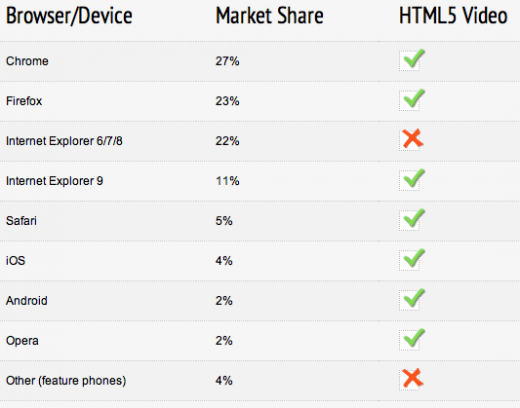
LongTail Video, the creators of JW Player, have found in a study that as much as 74% of the browser market now supports HTML5 video, up from 66% in January. The study, The State of HTML5 Video, follows HTML5’s emergence (paired with CSS3 and JavaScript), and will continue to be updated as this space is in constant flux.
HTML5 video faces a number of challenges before it can overtake Flash on the desktop, but it has already become a standard on iOS and Android. As LongTail notes, IE 6/7/8 will never support HTML5, but Google Chrome, Mozilla Firefox and the latest version of Internet Explorer all grew their share of the market since January, while non-supportive browsers continue to decline.
On with the study, LongTail also found that 90% of HTML5 video tag attributes are now supported across most browsers and devices and 80% JavaScript API features work reliably. Additionally, the study showed that 50% of browsers support full-screen playback, and only 30% of browsers support new accessibility elements like keyboard control and text tracks (the latter of which are literally brand new).

One challenge with HTML5 video is its fragmented support for audio/video formats. If nobody agrees on a standard, nothing will ever work across the board. At the moment, Firefox, Chrome and Opera support the WebM format, while IE, Safari, Chrome, iOS and Android support the MP4 format. The good news is that Firefox recently announced that it will soon support MP4.
Right now we’re close to the tipping point for HTML5 video, but it’ll be a little while longer before it becomes a new standard across all devices. Honestly, it will probably take full adoption from major video services like YouTube, Hulu and Vimeo before anyone can preach HTML5 video for every use case. Until then, now’s the perfect time to experiment to stay ahead of the game.
For more details, check out the full study below:
Get the TNW newsletter
Get the most important tech news in your inbox each week.




